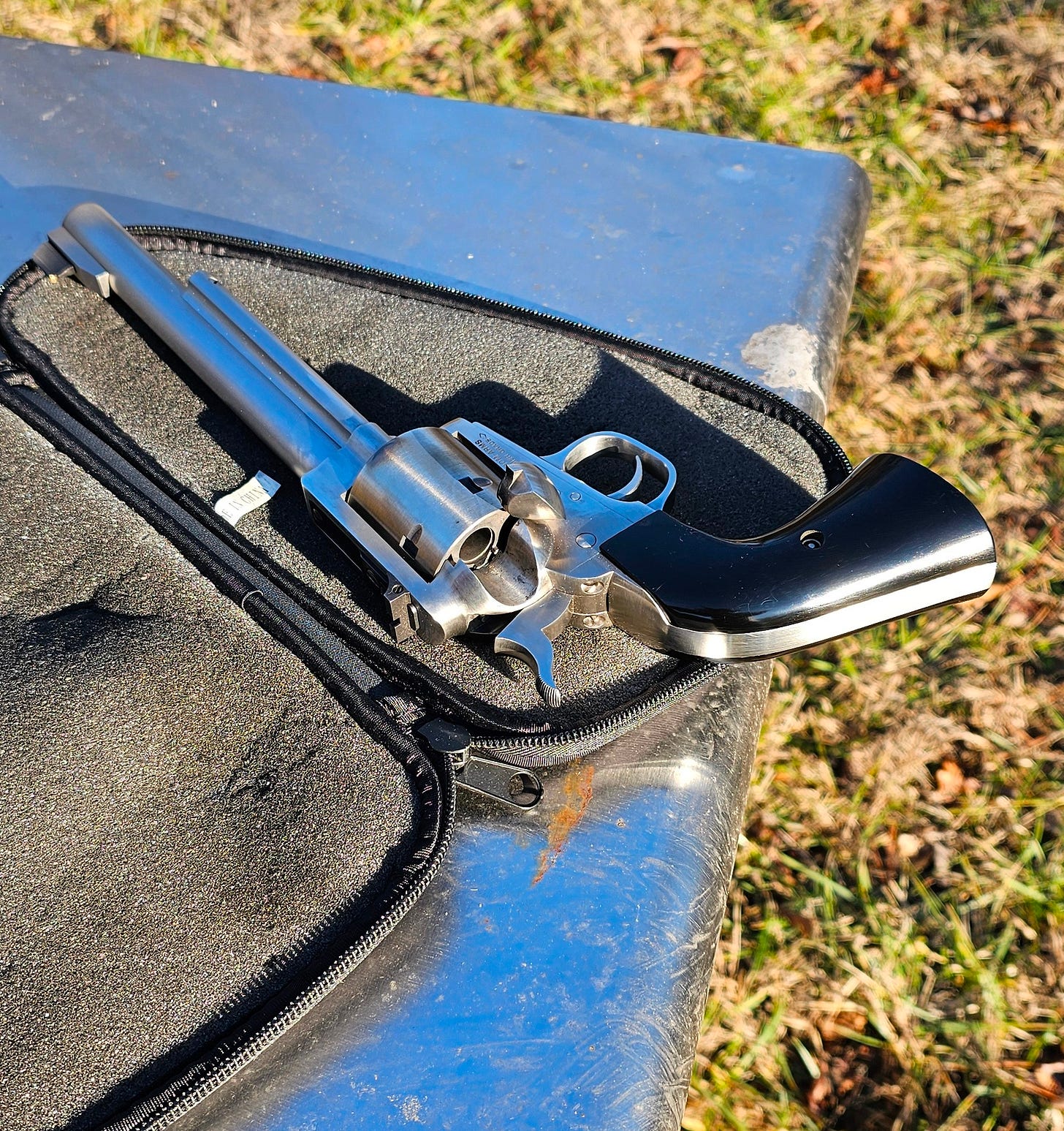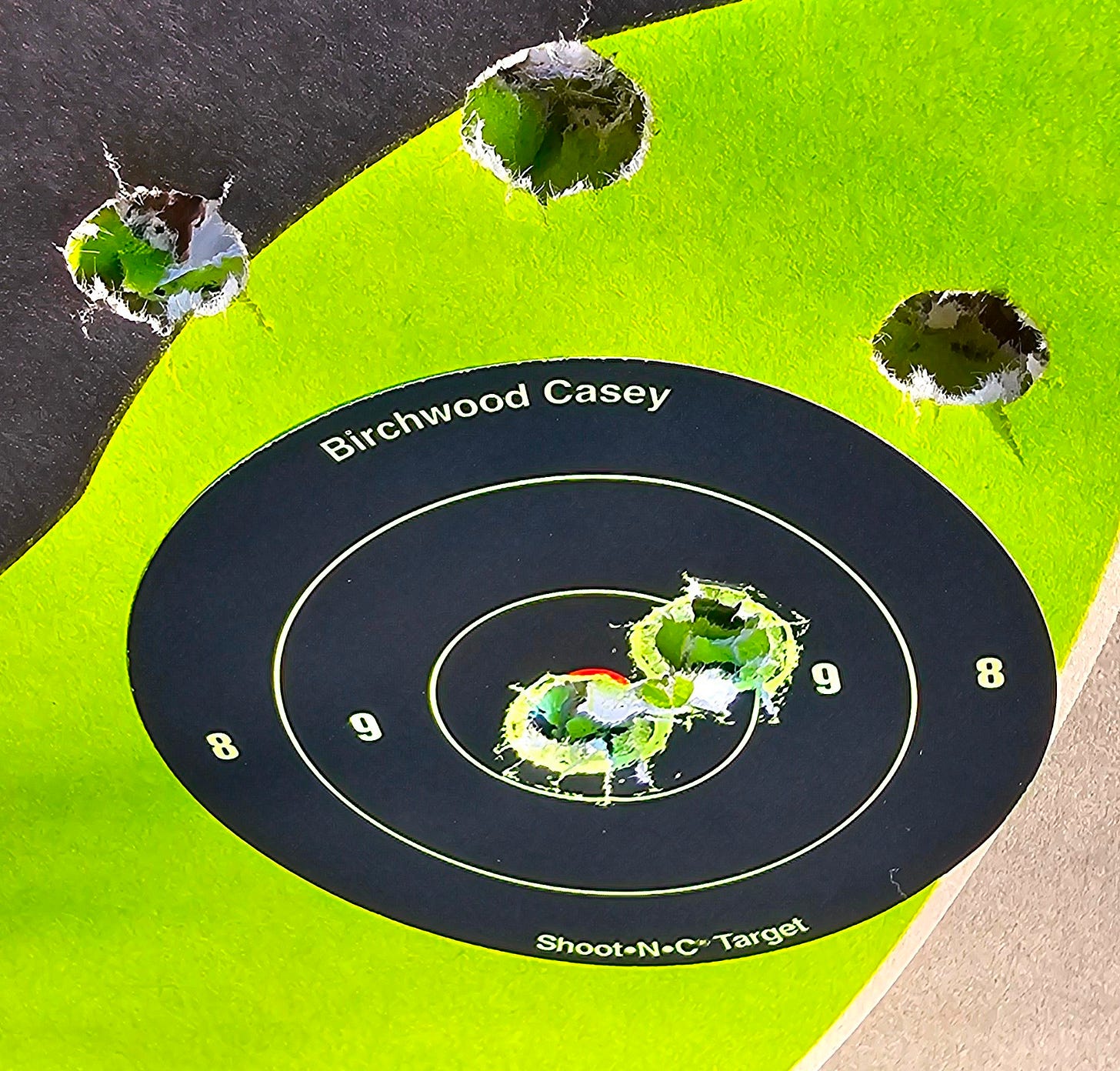While I’m finishing loading up my 45 Colt loads for my Henry BBX and Smith and Wesson 1854, I thought I would make a few loads for my Freedom Arms Model 83.
The Freedom Arms 83 was ordered by the previous owner as a 454 Casull, with a 45 colt cylinder. I shoot it primarily as a 45 Colt. I often use the loads I’ve developed for my rifles in this revolver.
Freedom Arms model 83 is one of the few revolvers strong enough to handle the higher pressures the modern 45 Colt loadings are capable of.
To give you an idea of the size of the revolver, here it is next to a Sig P226 SAO of mine.
Here is today’s setup

The targets, chronograph, drink, and range.

So, what did I load for it today?
Well, I decided to dig through my boxes of leftover cartridges and load them up for chronograph readings and target practice. Today, all of the cartridges use Hodgdon’s Copper Fouling Eraser-Pistol (CFEP) powder.
First up, Matt’s bullets 240 grain Hollow Base WadCutter, (HBWC.) All that means is the front is as wide as the back and flat. The rear has a cavity in it like a hollow point. That cavity expands when the round is fired, helping seat the bullet in the lands and grooves.
As you might guess, these rounds are not terribly aerodynamic. In fact, at fifty yards with a rifle, I’ve still not been able to get them, or the 38spl version of them, to group under three inches.

The results at 32 feet.

The chronograph readings.

The second load, a 245-grain Semi-WadCutter Gas Checked (SWC-GC.) I loaded 40 of these little gems. I shot twenty today through the revolver. The other twenty I’ll use when testing my rifles.

How was my five-shot group? Not too bad, not bad at all.

What about those chronograph numbers?

That is more like it. The round is subsonic, pleasant to shoot, and accurate. The discrepancy in velocity could be due to several factors.
First, the wadcutters were seated in the case fully, thus higher pressure.
Second, the wadcutter's hollow base created a better seal through the barrel, which could improve velocity.
Third, the gas check on the 245-grain SWC does impart more resistance than a straight lead bullet.
The third load of the day.

So, a little spoiler: this grouped beautifully.
What do the chronograph numbers tell us?

Load number four: in the past, this was my Henry BBX’s favorite 45 Colt load.

Did I mention it was 38 degrees outside and quite windy? I was quite chilled by this point in my shooting, shooting with leather work gloves, but I managed a respectable group. If I had time to practice more with this revolver, I could narrow these groups even further. It’s been more than a year since I’ve shot for group size with a revolver or pistol.

So, how is this bullet with its gas check in the velocity department?

The final rounds I loaded for this pistol today; the two others are loads developed for my rifles.

And boy-howdy did my cold hands notice the difference in recoil!

So, the numbers?

So what now? Well, I’ve a bunch of plinkers I’ve accumulated over the last few months of loading. Most of these are mixed head stamp brass and could be loaded with any number of things like: Hornady 185 grain XTPs to Blue Bullets 320 grain RNFPs. All of these are loaded for that 1070 fps out of my two rifles.
First up, Matt’s 260grain SWC again. This a ten-shot group.

What does the chrono say about a rifle load shot through a pistol?
A whopping 28.5 fps faster with the rifle’s load than with the dedicated revolver load. Honestly, I’d be fine using this through the revolver all the time, provided I could thaw out and get some real groups with it.
The next bullet I have is the round both of my rifles prefer, even more so than the Cast Performance 265-grain SWC-GC. This is Matt’s 285-grain Truncated Cone Gas Checked (TCGC) 8.3 grains of CFEP, seated at 1.67. Keep in mind this is a load developed for a rifle, used in a handgun designed for the 454 Casull. If you replicate this load, you do so at your own risk.
Again, not my best.

The chronograph numbers. The 285-grain TCGC is a far more aero-dynamic round than most of the others. I expected better accuracy, but as I said, at this point, I was a popsicle.

After half an hour of thawing and looking through what I received in the mail: bullets, sizing dies, swaging press, swaging dies, cleaning rods, and guides, I headed back outside.







Back outside, I thought I’d shoot up the rest of my plinkers. My excuse for being cold is gone; here’s the best of my groups.

The second set of five Blue Bullets 320-grain plonkers.

So, what conclusions can I draw from today’s shooting session? Well, I don’t think I need to download the cartridge loadings for this revolver. All of my plinkers in these last photos were Rifle loads. They performed admirably.
Maybe one day, I’ll bust out the IMR-4227 or the H-110 and see if I can push these puppies up to 1350-1400 fps. For now, though, these speeds are pleasant enough to shoot that I’ll gladly go outside in 38-degree windy weather to put some rounds down range.
The rifle session is coming soon.
I hope you’ve enjoyed the read.
~Evan.









